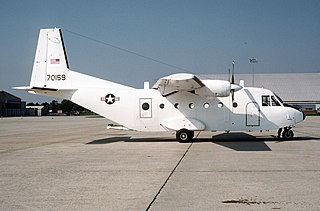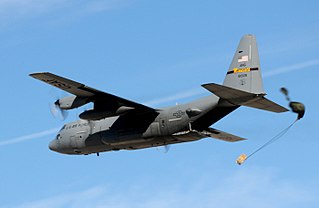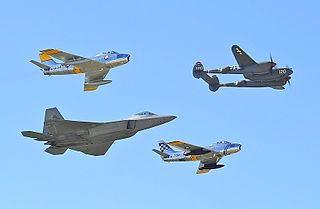
A military aircraft is any fixed-wing or rotary-wing aircraft that is operated by a legal or insurrectionary armed service of any type. Military aircraft can be either combat or non-combat:

USS Bataan (CVL-29/AVT-4), originally planned as USS Buffalo (CL-99) and also classified as CV-29, was an 11,000 ton Independence-class light aircraft carrier which was commissioned in the United States Navy during World War II.

Royal Air Force Bodney or more simply RAF Bodney is a former Royal Air Force Station located 4.5 miles (7.2 km) west of Watton, Norfolk, England.

Royal Air Force Station Wormingford or more simply RAF Wormingford is a former Royal Air Force station located 6 miles (9.7 km) northwest of Colchester, Essex, England.

Royal Air Force Fowlmere or more simply RAF Fowlmere is a former Royal Air Force station located 4.2 miles (6.8 km) northeast of Royston, Hertfordshire and 8.8 miles (14.2 km) southwest of Cambridge, Cambridgeshire, England.

Royal Air Force Leiston or more simply RAF Leiston is a former Royal Air Force station located 1.5 km (0.93 mi) northwest of Leiston and 1 km (0.62 mi) south of Theberton, Suffolk, England.

The 361st Fighter Group was a World War II United States Army Air Forces combat organization. It served primarily in the European Theatre of World War II.

The 359th Fighter Group was a United States Army Air Force fighter unit that was active during World War II at RAF East Wretham. The group had three fighter squadrons: the 368th, 369th, and 370th. The fighter group flew 346 combat missions over continental Europe and claimed 373 enemy aircraft in aerial duels and strafing attacks; probable destruction of 23; and damage to 185. It flew its last mission on 20 April 1945.

The 427th Special Operations Squadron is a specialized, covert unit of the United States Air Force. After reporter Andreas Parsch filed a Freedom of Information Act request, the Air Force told him the unit "support[s] training requirements … for infiltration and exfiltration." That is, it prepares troops for secretly slipping into and out of dangerous territory. The squadron is not listed by the Air Force Historical Research Agency. It is reported by the press to be stationed at Pope Field, North Carolina.
The 3rd Fighter Squadron (Commando) was a United States Air Force unit. Its last assignment was with the 3rd Air Commando Group, based at Chitose, Japan. It was disbanded on 8 October 1948.

Dinjan Airfield was a World War II airfield, located in Dinjan, approximately seven miles northeast of Chabua, in the state of Assam, India.

The 373d Fighter Group is an inactive United States Army Air Force unit. Its last assignment was with First Air Force stationed at Mitchel Field, New York. It was inactivated on 7 November 1945.

The 82d Operations Group is an inactive United States Air Force unit. It was last assigned to the 82d Training Wing, stationed at Williams Air Force Base, Arizona. It was inactivated on 31 March 1993.

The 339th Fighter Group was a unit of the United States Air Forces during World War II. It comprised the 503rd, 504th, and 505th Fighter Squadrons.

The 133rd Operations Group is the flying component of the Minnesota Air National Guard's 133d Airlift Wing, stationed at Minneapolis–Saint Paul Joint Air Reserve Station, Minnesota. If activated to federal service, the group is gained by Air Mobility Command of the United States Air Force.

The 352nd Fighter Group was a unit of the Eighth Air Force that was located in the European Theater of Operations during World War II. The unit served as bomber escort, counter-air patrols, and attacking ground targets. It initially flew P-47 Thunderbolt aircraft before converting to P-51 Mustang in April 1944. The group was located at RAF Bodney in England for the majority of its service and were nicknamed the Blue-nosed Bastards of Bodney due to the distinctive blue of the nose and upper cowl of the P-51 Mustangs of the group.

Patrick Dawson Fleming was a high-scoring World War II US Navy fighter ace, and later an accomplished US Air Force test pilot.
















